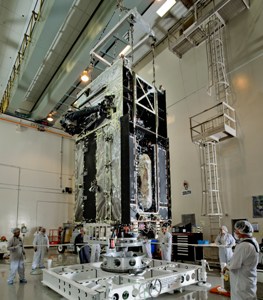Space- Based Infrared System from Lockheed Martin Prepared for Lift-Off in May
The Space Based Infrared System (SBIRS) geosynchronous (GEO-1) developed by Lockheed Martin was enclosed into its payload fairing on April 20th as part of the preparation for lift-off, which was scheduled in May.
 SBIRS
SBIRS
The SBIRS will take off onboard from the Atlas V rocket at the Cape Canaveral Air Force Station. The launch of SBIRS would help in improving the missile warning systems of the nation. Other important missions that would benefit from the launch are technical intelligence, missile defence and battle space awareness.
The GEO-1 consists of highly advanced scanning and starring sensors that are capable of showing high infrared sensitivity; thereby the number of re-visits over the constellation is greatly reduced. The scanning sensor is capable of offering a wide area observation of missile launches and natural processes around the earth. The staring sensor on the other hand is for surveying minor areas with increased sensitivity. The launch of GEO-1 promises accurate surveillance capabilities never seen before, at the global level to benefit the nation and its allies.
The Infrared Space Systems of the U.S Air Force Space and Missile Systems Center guides SBIRS team. Lockheed Martin is the primary contractor for this project, with Northrop Grumman being the payload integrator. Lockheed Martin has its head quarters at Bethesda, Md and is a global security company.
Please use one of the following formats to cite this article in your essay, paper or report:
APA
Choi, Andy. (2019, February 24). Space- Based Infrared System from Lockheed Martin Prepared for Lift-Off in May. AZoSensors. Retrieved on September 12, 2025 from https://www.azosensors.com/news.aspx?newsID=2630.
MLA
Choi, Andy. "Space- Based Infrared System from Lockheed Martin Prepared for Lift-Off in May". AZoSensors. 12 September 2025. <https://www.azosensors.com/news.aspx?newsID=2630>.
Chicago
Choi, Andy. "Space- Based Infrared System from Lockheed Martin Prepared for Lift-Off in May". AZoSensors. https://www.azosensors.com/news.aspx?newsID=2630. (accessed September 12, 2025).
Harvard
Choi, Andy. 2019. Space- Based Infrared System from Lockheed Martin Prepared for Lift-Off in May. AZoSensors, viewed 12 September 2025, https://www.azosensors.com/news.aspx?newsID=2630.
We're committed to providing free access to quality science. By registering and providing insight into
your preferences you're joining a community of over 1m science interested individuals and help us to
provide you with insightful content whilst keeping our service free.
or
Terms
While we only use edited and approved content for Azthena
answers, it may on occasions provide incorrect responses.
Please confirm any data provided with the related suppliers or
authors. We do not provide medical advice, if you search for
medical information you must always consult a medical
professional before acting on any information provided.
Your questions, but not your email details will be shared with
OpenAI and retained for 30 days in accordance with their
privacy principles.
Please do not ask questions that use sensitive or confidential
information.
Read the full Terms & Conditions.